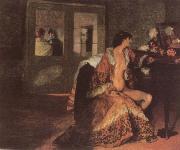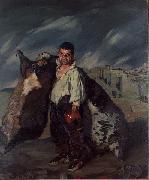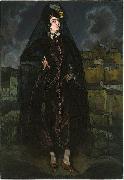|
Here are all the paintings of Ignacio Zuloaga 01
| ID |
Painting |
Oil Pantings, Sorted from A to Z |
Painting Description |
| 54428 |
 |
Celestina |
mk235
1906
Oil on canvas
|
| 73558 |
 |
Dwarf Gregorio |
Dwarf Gregorio
cjr |
| 75350 |
 |
Dwarf Gregorio |
Dwarf Gregorio
cyf |
| 51870 |
 |
Grape Pickers |
mk221
1905
Oil on canvas
213x191cm
|
| 72562 |
 |
Portrait of Anita Ramerez in Black |
Date ca. 1916(1916)
Medium Oil on canvas
Dimensions 190.8 X 130.8 cm (75.12 X 51.5 in)
cyf |
| 71413 |
 |
Portrait of Anita Ramxrez in Black |
ca. 1916(1916)
Oil on canvas
190.8 x 130.8 cm (75.12 x 51.5 in
|
| 56479 |
 |
portrait of countess mathieu de noailles |
mk247
c.1913,oil on canvas,59.875x77 in,152x195.5 cm,museo de bellas artes,bilbao,spain |
| 51826 |
 |
Portrait of Madame Corcuera |
mk221
1918
Oil on canvas
187.5x132cm
|
| 11859 |
 |
The Anchorite |
1907
6' 2'' x 3' 9 1/4''(188 x 115 cm)Bequest of Paul Cosson,1926 |
| 11861 |
 |
The Dwarf Dona Mercedes |
1899
4' 3 1/4'' x 3' 2 1/2''(130 x 97.5 cm) |
| 96628 |
 |
The Mexican castes |
1777(1777)
Medium oil on canvas
Dimensions 77 X 49 cm
cyf |
| 28513 |
 |
Young Village Bullfighters |
mk61
1906
Detail
|
| 28807 |
 |
Young Village Bullfighters |
mk61
1906
Oil on canvas
196x180cm
|
|
|
| Ignacio Zuloaga
|
| Spanish Painter, 1870-1945
was a Spanish Basque painter, born in Eibar, in the Basque country, near the monastery of Loyola. He was the son of metalworker and damascener Placido Zuloaga and grandson of the organizer and director of the royal armoury in Madrid. In his youth, he drew and worked in his father's workshop. He was educated by the Jesuits in France. His father wanted him to be an architect, and with this objective in mind, he was sent to Rome, where he immediately followed the strong impulse that led him to painting. After only six months' work he completed his first picture, which was exhibited at the Paris Salon of 1890. Continuing his studies in Paris, where he lived for five years, he was strongly influenced by Paul Gauguin and Henri de Toulouse-Lautrec. Only upon returning to his native land did he find his true style, which is based on the national Spanish tradition embodied in the work of Diego Velazquez, Francisco de Zurbaran, El Greco, and Francisco Goya. Bleeding Christ; or Blood Christ (El cristo de la Sangre) (1911)His own country was slow in acknowledging the young artist whose strong, decorative and rugged style stood in opposition to the styles of well-known modern Spanish artists such as Fortuny, Madrazo,
|
|

